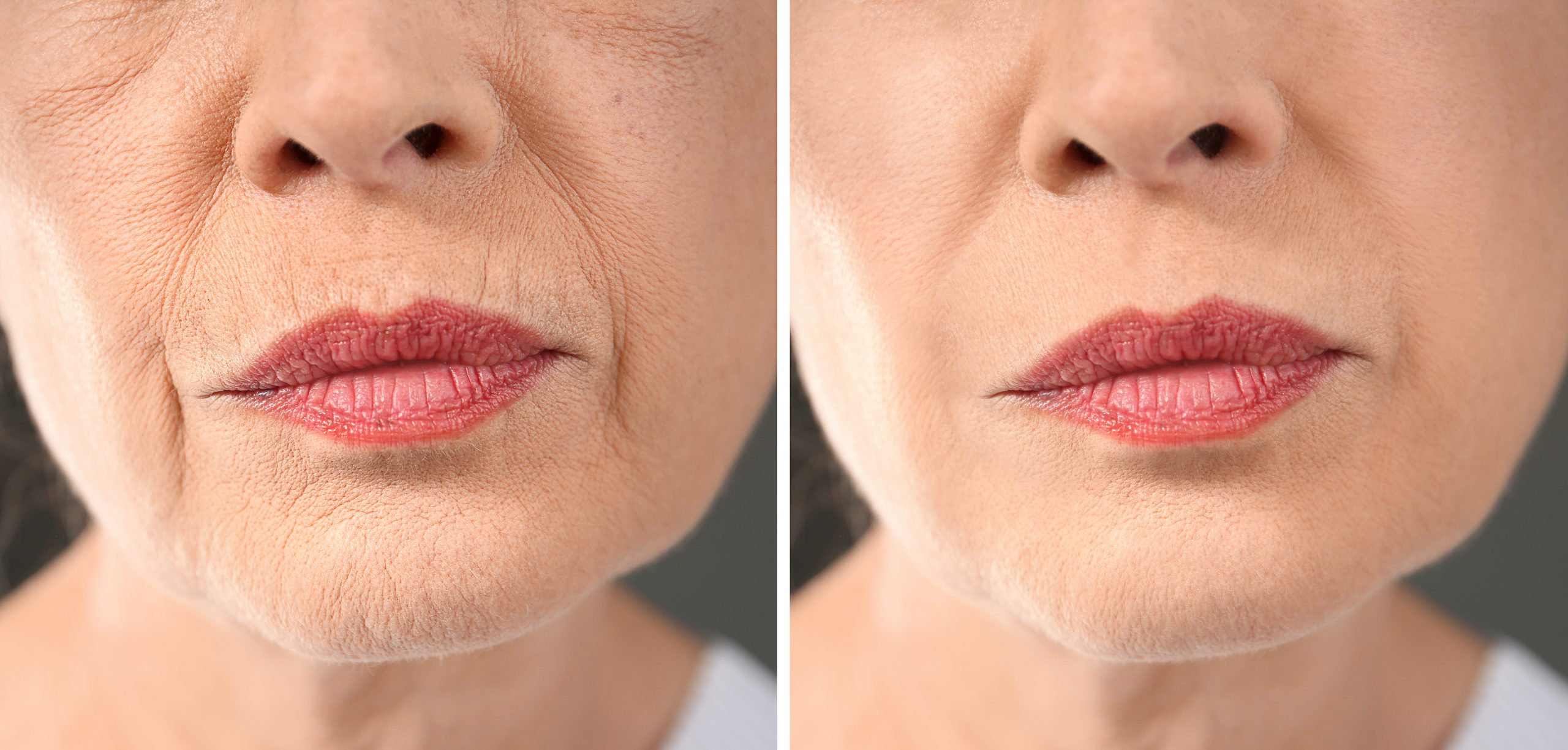
Ageing Prevention and Sunscreen
PHOTOAGEING
The biggest contributor to skin ageing is SUN EXPOSURE. The ultraviolet radiation of the sun interacts with our skin – particularly the dermis, the 2nd layer of the skin – and causes damage. Photoageing is the cause of damaged skin.
Photoageing can be seen on our face and hands – the parts of our body most often exposed to sunlight without protection.
if you look at the skin on the inside of the upper arm , you will see what our skin would be like if we were not exposed to the sun.
During photoageing our skin layers are affected differently by different wavelengths of UV light.
The Epidermis – (The upper layer)
During photoageing the epidermis thins, pales and becomes translucent due to short wavelength UV radiation (UVB). Changes in the epidermis lead to the development of both pre-cancerous and cancerous skin lesions.
The Dermis – (The 2nd Layer)
The dermis is susceptible to damage from longer wavelength UV radiation (UVA), which damages the support structures of the skin, especially collagen and elastin. In addition blood vessels are damaged causing easy bruising.
Fine and deep Wrinkles and sun spots are the two types of photoageing we see the most, and thus spend a lot of money trying to avoid. There are many different signs of photoageing that appear on our skin as we get older. These include:
- irregular pigmnentation – freckling, lentigines (small brown patches of skin)
- dryness (roughness) – roughness caused by a lack of moisture in the skin
- actinic keratosis – a rough, scaly patch on your skin that develops from years of exposure to the sun. Actinic keratosis is most commonly found on your face, lips, and ears, back of your hands, forearms, scalp or neck.
- elastosis – a condition in which skin appears yellow and thickened as a result of sun damage.
- wrinkling – fine surface lines, deep furrows
- venous lake – a small blood vessel (vein) in the skin, which over time has become enlarged
- telangiectasia – a condition in which there are visible small linear red blood vessels (broken capillaries)
- inelasticity – skin elasticity is the skin’s ability to stretch and then go back to normal once the need to stretch is gone. Reduced skin elasticity is a fact of ageing for most people.
- purpura – reddish-purple spots, which look like bruises, caused by blood vessels bursting and blood pooling under the skin
Many of these signs of aging will occur in all of us over time but you can slow them down by protecting your skin from the sun.
PREVENTION
Prevention is better than cure when it comes to the ageing of our skin.
HOW CAN I PREVENT SKIN AGEING?
The truth is, we cannot completely prevent signs of age from appearing on our skin. However , we can take steps to prevent premature skin ageing.
- Always apply sunscreen. In order to be effective, sunscreen must be broad-spectrum (protect against both UVA and UVB) and must be reapplied every two to four hours. Broad-spectrum sunscreens are better at protecting against DNA damage and photocarcinogenesis, and in delaying skin cancer development compared with non-broad-spectrum sunscreens. You should use a sunscreen that is at least SPF 30
- Avoid or minimise your time in the sun – between 10am-3pm from September to April when the UV levels are generally high. If you live in northern Australia (QLD, NT and WA) you should avoid exposure to the sun between 10am-3pm throughout the entire year. Ultraviolet light is strongest during these times.
- Wear a protective broad-brimmed and shirt made from high sun-protection material with a collar and long sleeves.
- Seek shade when outdoors
- Do Not smoke or GIVE it up.
- Eat Clean – less chemicals, more organic, more vegetables.
SMOKING AND SKIN AGEING :
- Like sun exposure, smoking cigarettes is a preventable cause of skin ageing.
- Smoking accelerates the skin ageing process through the nicotine in cigarettes. Nicotine in cigarettes causes narrowing of the blood vessels in the epidermis (the outer layer of your skin). This impairs blood flow to your skin, which means not as much oxygen and important nutrients flow to the skin.
- Cigarette smoking makes photoageing worse, particularly in women.
- Cigarettes also contain thousands of chemicals that damage collagen and elastin, which are fibres that give your skin its strength and elasticity. As a result, skin begins to sag and wrinkle. It is also possible that the facial expressions you repeat over and over again whilst smoking (often for decades) may contribute to wrinkles.
- There is a direct relationship between the number of pack-years smoked and the severity of wrinkling, greyish discoloration, acne-like changes (comedones), and drooping of the face.
- The skin also becomes dry and course, with uneven skin colouring and broken blood vessels. Smokers can also appear gaunt and may develop an orange or grey complexion.
- Smokers display poor wound healing capacity and have an increased risk of skin cancers
When should sunscreen be worn?
- People are advised to protect their skin btw the times of 10-3pm. from Sept to March
- If the UV index is 3 or more is called the “UV Alert”. This is the time that you need to protect your skin.
- Many people do not realise that the UV intensity is related to the date, not the temperature.
- Theoretically, the UV Index is highest when the sun is closest to us, that is at the time of the summer solstice, on December 21.
- In southern Australia, many people get sunburnt in springtime, when the weather is cool, but UV levels are moderately high.
SPF – SUNSCREEN
- Sunscreens are made of a mix of ingredients to help prevent the sun’s ultraviolet (UV) radiation reaching your skin and come in a range of SPFs.
2. SPF stands for Sun Protection Factor, and is a measure of a sunscreen’s ability to prevent one type of UV radiation called UVB (think B for burning) from damaging the skin. UVB rays cause sunburn and several types of skin cancer.
3. Red skin is a reaction to UVB rays and tells you little about other UV damage you may have done.
4. UVA radiation, penetrates deeper into the skin and can cause premature wrinkling, age spots and also heighten the risk of some skin cancers.
5. Sunscreen lotions labelled broad-spectrum block against UVA and UVB, but currently there is no standard listing for UVA block power.
6. Some inorganic chemicals that are found in sunscreen, including zinc oxide or titanium dioxide act as a physical sunblock that deflect both UVA and UVB rays. In the past, sunscreen showed up on the skin as a visible white layer however, sunscreen manufacturers now make the inorganic particles much smaller, so we don’t see the visible white (called nano-particles)
The Skin Health Institute recommends using a sunscreen with an SPF of 50+.
No sunscreen will block 100% of UV rays, which is why it is important not to spend prolonged periods of time in the sun, even whilst wearing sunscreen.
Some UV radiation still gets through the sunscreen and into your skin – the SPF number actually refers to roughly how long it will take for a person’s skin to turn red.
Sunscreen with an SPF of 15 will prevent your skin from getting red for approximately 15 times longer than usual. If you start to burn in 10 minutes without any sun protection, suncreen with SPF 15 will prevent you burning for about 150 minutes*.
If used correctly, SPF 15 suncreen filters out approximately 93 per cent of UVB rays, SPF 30 filters out 97 per cent and SPF 50 keeps out 98 percent.
However, most people don’t use enough sunscreen and because sunscreen tends to wear or wash off after time, you should reapply an SPF 50+ sunscreen every two hours, regardless of its strength.
HOW MUCH SUNSCREEN SHOULD I APPLY?
An average sized adult should apply the equivalent of one teaspoon of sunscreen to each arm, leg, front of the body, back of the body, and face (including the neck and ears). Most people apply less than half this amount, which means they get far less protection than the SPF stated on the bottle.
WHEN SHOULD I APPLY THE SUNSCREEN?
Sunscreen should be applied about 20 minutes before being out in the sun, so it has time to absorb into the skin. Once you are out in the sun and are sunburnt then sunscreen will be useless.
IS SUNSCREEN BY ITSELF ENOUGH?
Sunscreen should form part of overall sun protection that includes clothing, hats, seeking shade and avoiding being out in direct sunlight when it is brightest (SLIP on a shirt, SLOP on some sunscreen, SLAP on a hat, SEEK shade, SLIDE on sunglasses).
Does Vitamin D deficiency affect your skin ?
- A vitamin D deficiency can affect more than just your bones; it can affect your skin as well.
- Healthy vitamin D levels might help prevent skin from prematurely ageing but too much sun leads to accelerated skin ageing.
- Some studies have found that vitamin D can help treat skin conditions like dry skin, psoriasis, or eczema.
With more and more research showing that most don’t get enough Vitamin D , you might be wondering if a Vit D deficiency is actually a big deal for your overall health and well-being.
Getting enough vitamin D can impact your health in many ways, especially when it comes to your skin.
INSIDER spoke with two board-certified dermatologists and a registered nurse, and they explained the link between vitamin D and your skin, revealing why it’s crucial to get the right amount by way of adequate sun exposure, foods rich in Vitamin D, or supplements.
Foods rich in Vitamin D :
- oily fish, such as salmon, trout, mackerel and tuna
- eggs
- meat, particularly liver
- mushrooms – especially if you leave them in the sun for 15 minutes (!)
- fortified milk
“Vitamin D is a fat-soluble vitamin that is responsible for calcium homeostasis and bone health. Vitamin D increases the efficiency of calcium and phosphorus absorption from the small intestine and aids in the maturation of osteoclasts in the bone.”
Healthy levels of Vitamin D have been demonstrated to prevent skin ageing, promote healthy bone growth, possibly reduce the risk of certain cancers, and even improve mood
“Vitamin D deficiency results from lack of exposure to sunlight (for example: if you live in the northern hemisphere, [cover up with clothing, or simply avoid the sun and wear sunscreen]), IMPAIRED VITAMIN D ABSORPTION [due to a medical condition), MEDICATIONS impair Vitamin D absorption and low dietary intake. Individuals at highest risk are those who are institutionalized, the elderly, or those with more darkly pigmented skin.
Some people over the age of 50 have less ability to synthesise vitamin D from sunlight and are at a greater risk of osteoporosis and arthritis, fractures, muscle weakness, and cancers.
Vitamin D is largely linked to bone health but is also crucial for your skin’s health.
NEXT BLOG : CLEAN EATING – FOOD and NUTRITION
If you would like a complimentary Skin or Wellness consultation… please don’t hesitate to reach out or BOOK ONLINE
OR
You may email me at mgalanis@optusnet.com.au




